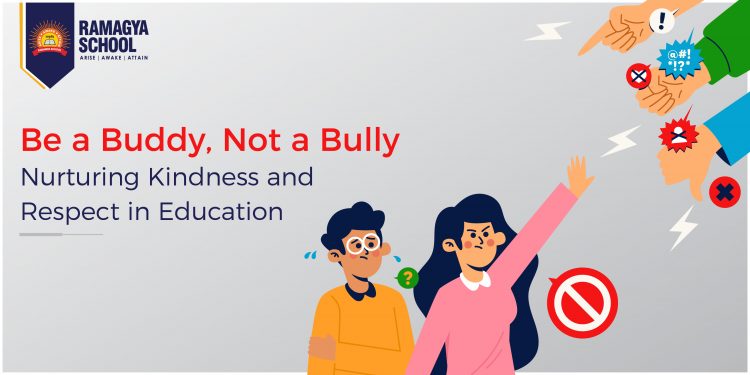Education extends far beyond textbooks and exams in today’s rapidly evolving world. It encompasses shaping compassionate and empathetic individuals who can contribute positively to society. As we strive to create inclusive and nurturing school environments, the importance of addressing the issue of bullying cannot be overstated. We explore the powerful message of “Be a Buddy, Not a Bully” and delve into ways schools, students, teachers, parents, and stakeholders can work together to foster kindness, empathy, and respect within educational settings.
Explore various types of bullying and knowledge to recognize them, and discuss proactive measures to address and prevent such behavior.
Let’s start by understanding the types of bullying in school:
- Physical Bullying: Physical bullying involves using physical force or aggression to harm and intimidate others. It may include hitting, kicking, pushing, or damaging personal belongings. This type of bullying is visible and often leaves visible marks, making it easier to identify. Schools and communities must intervene promptly to ensure the safety and well-being of the affected individuals.
- Verbal Bullying: Verbal bullying revolves around hurtful and demeaning language, including name-calling, insults, taunts, and spreading rumors. Verbal bullying can be equally damaging as physical bullying, causing emotional scars that may take longer to heal. Encouraging open communication and creating a culture of respect can help prevent and address verbal bullying.
- Cyberbullying: With the rise of technology, cyberbullying has emerged as a significant concern. This form of bullying occurs through electronic devices like social media, instant messaging, or emails. Cyberbullies may use hurtful comments, threats, or the spread of private information to target their victims. Parents, educators, and online platforms must collaborate to combat cyberbullying[1] effectively.
- Social Bullying: Social, relational, or emotional bullying involves manipulating social relationships to exclude or isolate individuals. It may include spreading rumors, purposefully excluding someone from groups, or damaging their social reputation. Social bullying can be challenging to detect as it often occurs subtly, but fostering a sense of inclusivity and empathy can help address this issue.
- Prejudicial Bullying: Prejudicial bullying is based on biases related to a person’s race, ethnicity, religion, gender, sexual orientation, or other characteristics perceived as different. This type of bullying stems from ignorance and intolerance and must be addressed through education, promoting diversity, and encouraging acceptance.
- Sexual Bullying: Sexual bullying involves unwelcome advances, comments, or behavior of a sexual nature that cause discomfort and distress. It can occur both in-person and online, affecting individuals of all ages. Schools and institutions must create safe spaces for victims to report such incidents and ensure appropriate actions are taken against the perpetrators.
Understanding the Impact of Various Types of Bullying in School:
Bullying is a widespread issue that affects students of all ages, causing profound emotional and psychological harm. It can take various forms, including physical, verbal, and cyberbullying, and its consequences extend beyond the immediate victim. Bullying creates an environment of fear, insecurity, and exclusion, impeding individuals’ overall well-being and academic success.
Promoting a Culture of Kindness:
- Education and Awareness: To tackle the issue of bullying effectively, schools must prioritize education and awareness. Establish programs and initiatives that educate students, teachers, and parents about the different forms of bullying, its impact, and the importance of fostering a culture of kindness and respect. Conduct workshops, guest speaker sessions, and classroom discussions to raise awareness and empower individuals with the knowledge and skills to prevent and address bullying.
- Inclusive Policies and Procedures: Schools are crucial in creating safe, inclusive environments promoting positive social interactions. Develop comprehensive anti-bullying policies and procedures that clearly define behavior expectations, outline bullying consequences, and provide avenues for reporting incidents. Ensure that these policies are consistently enforced and communicated to all stakeholders.
- Empathy and Social-Emotional Learning: Integrating empathy and social-emotional learning into the curriculum is essential for nurturing students’ emotional intelligence and fostering positive relationships. Incorporate activities and lessons that promote empathy, self-awareness, and conflict-resolution skills. Encourage open dialogue and create safe spaces where students can express their feelings, concerns, and experiences without fear of judgment or retaliation.
- Peer Support and Mentoring Programs: Establish peer support programs that pair older students with younger ones, creating positive role modeling, friendship, and guidance opportunities. These programs foster a sense of belonging and provide platforms for older students to become ambassadors for kindness, compassion, and inclusivity.
- Parent and Community Engagement: Collaboration between schools, parents, and the community is vital in addressing bullying effectively. Engage parents through workshops, seminars, and informational sessions to educate them about the signs of bullying, ways to support their children, and the importance of promoting respectful behavior at home. Foster partnerships with community organizations that can provide additional resources and support in creating a safe and inclusive school environment.
Creating a school environment where students can flourish academically, emotionally, and socially requires a collective effort. By embracing the “Be a Buddy, Not a Bully” approach, schools can foster kindness, empathy, and respect and combat the damaging effects of bullying.
Through education, inclusive policies, social-emotional learning, peer support programs, and parent and community engagement, we can nurture a generation of compassionate and responsible individuals who value the power of unity, acceptance, and understanding.
“Kindness is the language which the deaf can hear, and the blind can see.” – Mark Twain.
Together, let us strive to be buddies, not bullies, and create a school environment where every student feels safe, supported, and valued. By cultivating a culture of kindness, we can empower our students to impact their schools, communities, and the world positively.
Note: The information provided in this blog is for educational purposes only and should not replace professional advice. Schools should consult with experts and follow regional guidelines and regulations regarding bullying prevention and intervention.





